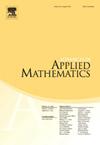Random walks, equidistribution and graphical designs
IF 1.3
3区 数学
Q3 MATHEMATICS, APPLIED
引用次数: 0
Abstract
Let be a d-regular graph on n vertices and let be a probability measure on V. The act of moving to a randomly chosen neighbor leads to a sequence of probability measures supported on V given by , where A is the adjacency matrix and D is the diagonal matrix of vertex degrees of G. Ordering the eigenvalues of as , it is well-known that the graphs for which is small are those in which the random walk process converges quickly to the uniform distribution: for all initial probability measures and all , One could wonder whether this rate can be improved for specific initial probability measures . We show that if G is regular, then for any , there exists a probability measure supported on at most ℓ vertices so that
随机漫步,均匀分布和图形设计
设G=(V,E)是n个顶点上的一个D正则图,设μ0是V上的一个概率测度。移动到随机选择的邻居的行为会得到V上支持的一系列概率测度,由μk+1=AD−1μk给出,其中a为邻接矩阵,D为G顶点度数的对角矩阵。将AD−1的特征值排序为1=λ1≥|λ2|≥…≥|λn|≥0,众所周知,|λ2|较小的图是那些随机漫步过程迅速收敛于均匀分布的图:对于所有初始概率测度μ0和所有k≥0,∑v∈v |μk(v)−1n|2≤λ22k。人们可能想知道,对于特定的初始概率度量μ0,这个速率是否可以提高。我们证明了如果G是正则的,那么对于任意1≤r≤n,存在一个支持在最多r个顶点上的概率测度μ0,使得∑v∈v |μk(v)−1n|2≤λ r +12k。
本文章由计算机程序翻译,如有差异,请以英文原文为准。
求助全文
约1分钟内获得全文
求助全文
来源期刊

Advances in Applied Mathematics
数学-应用数学
CiteScore
2.00
自引率
9.10%
发文量
88
审稿时长
85 days
期刊介绍:
Interdisciplinary in its coverage, Advances in Applied Mathematics is dedicated to the publication of original and survey articles on rigorous methods and results in applied mathematics. The journal features articles on discrete mathematics, discrete probability theory, theoretical statistics, mathematical biology and bioinformatics, applied commutative algebra and algebraic geometry, convexity theory, experimental mathematics, theoretical computer science, and other areas.
Emphasizing papers that represent a substantial mathematical advance in their field, the journal is an excellent source of current information for mathematicians, computer scientists, applied mathematicians, physicists, statisticians, and biologists. Over the past ten years, Advances in Applied Mathematics has published research papers written by many of the foremost mathematicians of our time.
 求助内容:
求助内容: 应助结果提醒方式:
应助结果提醒方式:


